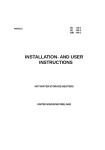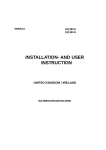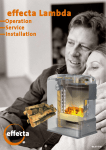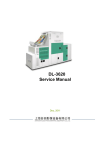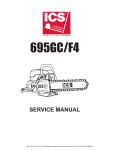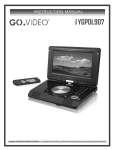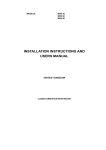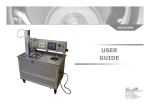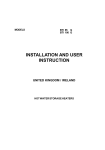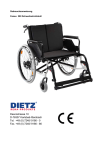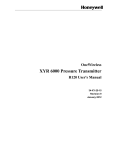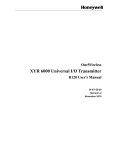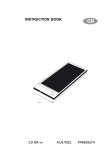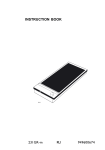Download INSTALLATION INSTRUCTIONS AND USER'S MANUAL
Transcript
MODELS ADMP ADMP ADMP ADMP ADMP ADMP 40 G 50 G 60 G 80 G 90 G 115 G INSTALLATION INSTRUCTIONS AND USER'S MANUAL UNITED KINGDOM WATER HEATERS FOREWORD Before attempting to install this water heater please read the installation instructions. Read the user’s manual before first igniting the heater. Failure to follow these instructions meticulously could lead to risk of an explosion and/or fire and can cause material damage and/or physical injuries. An accredited installer must install the heater and commission it for the first time. The type of gas and the values are preset (ex works) and are given on the model plate. The heater may only be installed in an area of which the available clearances comply with the required ventilation regulations. The ADMP models are fitted with a permanent pilot light. A.O.SMITH CANNOT ACCEPT ANY RESPONSIBILITY FOR GUARANTEE, SERVICE AND/OR PRODUCT LIABILITY IN THE EVENT OF UNAUTHORISED CHANGES, PRODUCT MODIFICATIONS OR REPAIRS. 2 CONTENTS PAGE PILOT-LIGHT HEATERS (modellen ADMP 40 t/m 115) 1 1.1 1.2 1.2.1 1.2.2 1.2.3 1.3 1.3.1 1.3.2 GENERAL Description of the heater ................................................................................................................ 4 Technical safety equipment ............................................................................................................ 5 Gas control block ............................................................................................................................ 5 Control box ...................................................................................................................................... 5 Thermal reflux safeguard (TRS) ..................................................................................................... 5 Technical description ...................................................................................................................... 6 Dimensions .................................................................................................................................... 6 Technical data ................................................................................................................................. 8 2 2.1 2.1.1 2.1.2 2.1.3 2.1.4 2.1.5 2.1.6 2.1.4 FOR THE INSTALLER Installation instructions ................................................................................................................. 10 Installation ..................................................................................................................................... 10 Water connection .......................................................................................................................... 10 Gas connection ............................................................................................................................. 12 Flue system ................................................................................................................................... 12 Flue-gas discharge ....................................................................................................................... 12 Thermal reflux safeguard (TRS) ................................................................................................... 13 Electrical connection ..................................................................................................................... 13 2.2 2.2.1 2.2.2 2.2.3 2.3 2.4 2.5 2.6 2.7 2.8 2.9 2.10 2.11 Commissioning ............................................................................................................................ 14 Filling the heater ........................................................................................................................... 14 Commissioning ADMP models .................................................................................................... 14 Setting the pilot light ...................................................................................................................... 14 Shutting down ............................................................................................................................... 14 Operation/temperature control ..................................................................................................... 14 Setting the nominal loads ............................................................................................................. 15 Conversion to another gas ........................................................................................................... 15 Maintenance .................................................................................................................................. 17 Anode ............................................................................................................................................ 17 Deliming ........................................................................................................................................ 17 Condensation ............................................................................................................................... 17 Spare parts ................................................................................................................................... 17 3 3.1 3.1.1 3.1.2 3.1.3 3.2 3.3 3.4 FOR THE USER Instructions for use ....................................................................................................................... 18 Warning ......................................................................................................................................... 18 Filling the heater ........................................................................................................................... 18 Commissioning ADMP models .................................................................................................... 18 Operation ...................................................................................................................................... 18 Shutting down ............................................................................................................................... 18 Maintenace .................................................................................................................................... 18 4 4.1 4.1.1 4.1.2 4.1.3 4.1.4 4.2 WHAT TO DO IN CASE OF A FAILURE General ......................................................................................................................................... 19 Overheat thermostat ..................................................................................................................... 19 Thermal Reflux Safeguard (TRS) ................................................................................................. 19 Wrong hot water temperature ....................................................................................................... 19 Water temperature too high .......................................................................................................... 19 Fault overview ................................................................................................................................ 20 5 WARRANTY Garantee in general ...................................................................................................................... 21 Garantee of the tank ...................................................................................................................... 21 Conditions for installation and use .............................................................................................. 21 Exclusions ..................................................................................................................................... 21 Range of the quarantee ................................................................................................................ 21 Claims ........................................................................................................................................... 21 No other quarantee or warranty either expressed or implied is made on behalf of A.O. SMITH WATER PRODUCTS COMPANY ........................................................................... 21 5.1 5.2 5.3 5.4 5.5 5.6 5.7 Appendix 1 Electrical scheme ADMP-models ................................................................................................. 22 3 PILOT LIGHT HEATERS (MODELS ADMP) 1. GENERAL 1.1 Description of heater Construction methods and equipment of the heaters are in accordance with the European standards for gasfired hot water heaters for sanitary use (EN 89). The heaters are therefore comply with the European Guidelines for Gas Heaters and are therefore permitted to carry the CE hallmark. These are open flued heaters without mechanical ventilator, with a Thermal Reflux Safeguard (TRS) (heater category B11BS ). The heaters are suitable for use with a working pressure of up to 8 bar. The cylindrical tank is made from sheet steel containing a number of vertically placed flue tubes. For protection against corrosion, the inside of the tank is enamelled. The tank is also fitted with a number if magnesium anodes for extra protection against corrosion. A thick PU insulating layer between the tank and the steel jacket helps to reduce unnecessary heat loss. 1 2 3 4 5 6 7 8 9 10 11 12 13 14 15 16 17 18 19 20 When the heater is completely filled with water, it is under continual mains water pressure. When hot water is drained from the heater, cold water immediately enters the heater. For effective heat transfer flue baffles have been included in the flue tubes. Heat from the fluegases is transferred to the water by means of radiation and convection. The flue-gases are guided to the chimney via a rotateable and removable draught diverter. Flue-gases are discharged by thermal draught. The atmospheric burner consists of a number of bar burners. One injector is screwed into the manifold for each bar burner. The function of the injectors in the inlet venturi ensures a good mixture of gas and primary air. Secondary air is drawn in between the bar burners. The permanent piliot light ensures that the burner ignites as soon as there is a demand for heat. A radiation shield is fitted beneath the burner which also serves to collect any condensate (see diagram 1) Draught diverter High-limit and overheat thermostat sensors Hot-water outlet Thermostat sensor Control box Cold-water inlet Drain cock Thermocouple Pilot burner Gas control block Flue-pipe connection Covering plate for flue-damper assembly Support for draught diverter T&P connection (temperature and pressure valve) Anode Flue tubes Flue baffles Insulation Bar burners Radiation shield/condensate tray Diagram 1- Cross-section ADMP-models 4 1.2 TECHNICAL SAFETY EQUIPMENT 1.2.1. Gas control block the heaters are equipped with a gas control block which regulates the flow of gas to the burner. The gas control block is equipped with a safety valve, gas control valve, pilot light pressure control and burner control (on a standard natural gas setting). The safety valve is controlled by the millivoltage generated when the thermocouple is heated by the permanent pilot. To ensure improved ignition the gas control valve opening mechanism is fitted with a delay (softlite). The control box is fitted with an ON/OFF switch (I/O). At setting I, the gas control block is controlled on the basis of heat demand from the control thermostat. At setting O the heater is switched off. 1.2.3. Thermal Reflux Safeguard The heater is equipped with a Thermal Reflux Safeguard (TRS), which consists of a temperature sensor and thermostat fitted to the draught diverter. The function of the TRS is to switch off the heater if flue gases pass through the draught diverter and enter the area in which the heater is installed instead of being expelled via the chimney. 1.2.2. Control box Temperature control for the water heater is housed in the control box. For safety purposes, heaters are always filled with three thermostats: a control thermostat, a high-limit thermostat and an overheat thermostat. The desired water temperature is set with the control thermostat. The overheat thermostat prevents the water reaching too high a temperature. Diagram 2- Control box ADMP-models Should both control and high-limit thermostats malfunction, the overheat thermostat will automatically shut down the heater. The overheat thermostat breaks the thermocouple circuit, which closes the safety valve, cutting of the supply of gas to the pilot burner which extinguishes the pilot light. The control thermostat can be set at settings 1-4 (approx. 40ºC to 73ºC). the switch temperature of the high-limit thermostat is 84ºC; the overheat thermostat cuts in at 93ºC. The sensor for the control thermostat is located at the level of the control box; the sensors for the high-limit and overheat thermostats are located near the top of the heater. 5 1.3 TECHNICAL DESCRIPTION 1.3.1 Dimensions (see diagram 3) The heaters must be connected to a flue with a minimum of the prescribed diameter (see size G). Connection to a pipe of a larger diameter by means of a coupling is permitted. Size ADMP 40 ADMP 50 ADMP 60 ADMP 80 ADMP 90 ADMP 115 A 1900 2100 1900 2100 2000 2085 B 1760 1960 1760 1960 1795 1870 D 710 710 710 710 710 710 E 800 800 800 800 800 800 F 1100 1100 1100 1100 1105 1105 G 150 150 180 180 225 225 H 660 660 660 660 675 675 J 1840 2040 1840 2040 1935 2010 K 205 205 205 205 205 205 L 400 400 400 400 400 405 M 565 565 565 565 575 650 N 1605 1810 1605 1810 1640 1715 P 730 730 730 730 740 825 R 500 515 500 515 525 600 S 1550 1760 1550 1760 1595 1660 1 Cold water inlet 2 Hot water outlet 3 Gas control block 4 Drain cock 5 T&P-connection (temperature and pressure valve) 6 Covering plate for inspection hatches All measurements are given in millimetres (rounded off to the nearest 5 mm). 6 Diagramm 3 - dimensions ADMP 7 1.3.2. Technical data Heater categorie II2H3+ DESCRIPTION Unit ADMP 40 ADMP 50 ADMP 60 ADMP 80 ADMP 90 ADMP 115 Nominal input (lower value) kW 38.0 50.9 59.8 74.3 88.5 114.0 Nominal output kW 32.3 42.8 50.2 62.4 74.3 95.8 Inlet pressure (G20) mbar 20 20 20 20 20 20 Burner pressure (G20) mbar 8.5 8.5 8.5 8.5 8.5 8.5 Gas consumption * (G20) m3/h 4.0 5.4 6.3 7.9 9.4 12.1 Diameter main injector (G20) mm. 3.20 3.20 3.10 2.95 3.20 3.20 Diameter pilot light injector (G20) mm 0.56/0.41 0.56/0.41 0.56/0.41 0.56/0.41 0.56/0.41 0.56/0.41 Heating time ∆T = 45K min. 30 26 19 17 12 8 kW 38.4 51.0 62.9 74.5 88.7 114.0 Inlet pressure (G30) mbar 30 30 30 30 30 30 Burner pressure (G30) mbar 30 30 30 30 30 30 Gas consumption * (G30) kg/h 3.0 4.0 5.0 5.9 7.0 9.0 Diameter main injector (G30) mm. 1.70 1.70 1.70 1.50 1.70 1.70 Diameter pilot light injector (G30) mm. 0.25 0.25 0.25 0.25 0.25 0.25 Heating time ∆T = 45K min. - - - - - - kW 35.3 47.0 58.2 71.5 82.4 104.0 Inlet pressure (G31) mbar 37 37 37 37 37 37 Burner pressure (G31) mbar 37 37 37 37 37 37 Gas consumption * (G31) kg/h 2.7 3.7 4.5 5.6 6.4 8.1 Diameter main injector (G31) mm. 1.70 1.70 1.70 1.50 1.70 1.70 Diameter pilot light injector (G31) mm. 0.25 0.25 0.25 0.25 0.25 0.25 Heating time ∆T = 45K min. - - - - - - NATURAL GAS DATA G20-20mbar BUTANE DATA G30 - 30 mbar Nominal input (lower value) PROPANE DATA G31 - 37 mbar Nominal input (lower value) * Gas consumption at 1013,25 mbar and 15°C 8 GENERAL Storage capacity litre 309 357 298 355 278 253 Numbers of bar burners - 3 4 5 7 7 9 Number of anodes - 2 2 2 3 3 4 Number of flue tubes - 5 6 7 9 12 16 Water connections - Rp 1½ Rp 1½ Rp 1½ Rp 1½ Rp 1½ Rp 1½ Gas connection - Rp ¾ Rp ¾ Rp ¾ Rp ¾ Rp ¾ Rp ¾ Drain cock - ¾" NPT ¾" NPT ¾” NPT ¾" NPT ¾" NPT ¾” NPT Anode - ¾" NPT ¾" NPT ¾” NPT ¾" NPT ¾" NPT ¾” NPT T&P - plug connection - 1"NPT 1"NPT 1"NPT 1"NPT 1"NPT 1"NPT Maximum working pressure bar 8 8 8 8 8 8 Weight (empty) kg 195 221 209 238 244 270 9 2. FOR THE INSTALLER 2.1. INSTALLATION INSTRUCTIONS This water heater must be fitted in a location which will permit the provision of an approved flue system and adequate ventilation. The water heater must stand on a level surface resistant to heat and with sufficient strength to support the weight of the unit when full of water. This water heater must not be installed in a bathroom, bedroom or in a cupboard opening on to such rooms. This water heater must not be installed in any area where flammable materials are used or stored. Insufficient ventilation may give rise to a risk of fire, explosion or suffocation. If in doubt consult the national and local regulations governing the installation of gas appliances or your local British gas service department. 2.1.1 Installation These water heaters must be installed by a qualified competent installer, in accordance with the following standards and regulations. Gas safety (installation and use) regulations 1944. BS 5440 part 1 1990 part 2 1989 Installation should be carried out in accordance with all local authority and building regulations, local water authority and fire regulations and the following British standards: British Gas Publication UP1 and UP2. BS 5482 part 1 1979 part 2 1979 part 3 1979 BS 6644 BS 6700 BS 6798 Some chemicals produce vapours which can cause rapid failure of thermocouples, burners and storage tanks if they ware drawn into the combustion air supply. Therefore if this water heater will be used to supply hot water to: - hairdressers - dry cleaners - industrial degreasing processes or any other area where compounds containing halogens are used and stored, care should be taken that all primary and secondary air is drawn from outside atmosphere free of such contaminents. For further advise contact A.O.Smith. 2.1.2 Water connections A.O.Smith water heaters are suitable for connection to vented, unvented and pumped pressurised systems. In each case appropriate valves and fittings should be used to ensure the system complies with the requirements of the water by laws, and appropriate building regulations. When fitting it is essential the rules of ‘good practice’ are applied at all stages of installation. Vented systems If the water heater is to be connected to a cold feed tank of cistern the hot water supply pipe must include an open vent which discharges over the cold feed cistern. The cold feed cistern must have an actual capacity of greater volume than the hourly recovery rate of the water heater(s) which it supplies. The minimum actual capacity is 50 gallons or 227 litres. See diagram 4. 1 2 3 4 5 6 7 Gas cock Stop valve Three way vent valve T&P vlave Non-return valve Circulation pump Drain valve A B C D E Gas Supply Hot Water Cold Water Overflow Return Circulation Diagram 4 – Typical UK vented system 10 Unvented To install an A.O.Smith water heater on an unvented cold water supply system a kit of valves and fittings listed by the water research centre and complying with part G3 of the current building regulations and BS 7206 should be used. Installation should be carried out generally as shown on diagram 5. 1 2 3 4 5 6 7 8 9 Gas cock Stop valve Expansion vessel T&P valve Non-return valve Circulation pump Drain valve Pressure limiting valve Expansion valve A B C D E Gas Supply Hot Water Cold Water Hot Water Supply Return Circulation Diagram 5 – Connection diagram (unvented system) A.O.Smith water heaters are tested to a maximum pressure of 12 bar and a maximum working pressure of 8 bar. Dead legs on a hot water installation are undesirable. Where possible they should be avoided. Where the inclusion on the system of a dead leg is unavoidable the following restrictions should be applied: - for pipes not exceeding 19 mm. Inside diameter; maximum length of dead leg permitted 12.0 metres; - for pipes exceeding 19 mm. But not exceeding 25 mm. Inside diameter; maximum length of dead leg 7.5 metres; - for pipes with an inside diameter exceeding 25 mm. maximum dead leg 3.0. metres. Depending on the length and insulation of the water piping and the water demand frequency, it may be necessary to install a circulation system on the drain cock. The return pipe of the circulation piping can be fitted on the top of the drain cock after the sealing plug has been removed (see diagram 6). Diagram 6 – Connection point for the return piping. 11 Depending on the water demand pattern (e.g., small amounts frequently), it may be necessary to circulate the water in the heater to prevent temperature stratification. Therefore, we recommend that a circulation system is installed in the event of such demand patterns (see diagram 7) 1 2 3 4 Pump (type: Grundfos UP 20-15 N 150 or equivalent) Non-return valve Gate valve Drain valve A B C D Cold water Hot water Return circulation Gas supply Diagram 7 – Connection diagram including destratification circulation system 2.1.3 Gas connection The gas supply to this appliance must be installed in accordance with BS 6891 (1988) and British Gas Publications Up1 and UP2. Fit the ¾” gas supply cock supplied with this unit immediately before the gas control block. No heat or soldered joints should be applied in the vicinity of the gas control block, as they could cause damage to the control. All connections and joints should be tested for gas soundness with a suitable leak detector (do not use a naked flame) NB. When operating this unit on LPG a suitable gas supply cock should be used) 2.1.5 Flue-gas discharge The horizontal draught diverter supplied separately must be used to connect the heater to the chimney The draught diverter can be turned to ensure that the distance to the discharge duct is as short as possible. Once the position has been determined, drill two small holes (3.2 mm.) to fix the support bracket (fitted to the pallet) below the draught diverter (see diagram 8). 2.1.4 Flue system The water heater should be fitted with a flue system connected to the draught diverter. The flue pipe should rise for at least 50 cm. vertically before the inclusion of any bends. If a horizontal run of flue is required this should be kept to a minimum length possible and incorporate a rise of 6 cm. per metre of run. A split clip or flange should be provided in the flue close to the draught diverter for ease of servicing. All flue materials should be corrosion resistant i.e. stainless steel or galvanised and must include a tested and approved terminal to BS 5440 part I. 12 Diagram 8 – Position draught diverter Then drill two small holes in the top lid of the heater and fix the draught diverter with the two self-tapping screws provided (see diagram 9). The stainless steel discharge pipe must have at least the same diameter as the connection on the draught diverter. The discharge pipe must start from the draught diverter with a vertical section of at least 0.5 m. No modifications may be made to the draught diverter discharge or any covers attached to it. 2.1.7 Electrical connection All electrical connections must be carried out in accordance with IEE regulations by an accredited electrical installation company. The control box of the ADMP models must be connected to the mains by means of a permanent electrical connection. A main switch must be fitted in the phase between the permanent connection and the heater. The feeder cable must have cores of at least 3 x 1.0 mm². Always check with a voltage tester if the phase and the zero have been connected correctly in the control box. The electricity supply must comply with the requirements below: Electricity supply 220/240 V AC (-15% / +10%) Frequency 50 Hz (+/- 2%) Electrically fuse to a minimum of 16 A The electricity diagram can be found in the appendix Diagram 9 – Fitting the draught diverter 2.1.6 Thermal Reflux Safeguard (TRS) The temperature sensor and the thermostat of the Thermal Reflux Safeguard (TRS) must be mounted on the draught diverter in the correct way and in the proper position. Do this as follows: 1 Remove the TRS from the packaging. 2 Insert the temperature sensor from the outside through the hole in the draught diverter. 3 Mount the thermostat onto the draught diverter with the self-tapping screws provided (see diagram 10) 4 Mount the temperature sensor at the correct position on the lower edge of the draught diverter by means of the clamps and the M4 screws provided (see diagram 10) 5 Fix the TRS cabling on the draught diverter with two clamps (see diagram 9). 6 Lead the TRS cabling to the cable duct on the heater. Fix the cabling to the heater with the remaining clamps. Diagram 10 – Mounting the TRS on the draught diverter 13 2.2 COMMISSIONING 2.2.1 Filling the heater 1 2 3 Fit drain cock and check that it is closed Open the cold-water tap to the heater and all hotwater outlets in order to remove all air from the system. The heater has been filled when cold water runs out at all outlets. Close all the hot-water taps. The heater is now under mains pressure 9 Turn the temperature control dial to the desired position, position 3 (approx. 60ºC) is recommended. The burner ignites; the heater will now operate automatically 10 Check the inlet pressure and burner pressure on the manometer which can be connected to the pressuretest nipple. The heater must not be operational while the manometer is being connected! 2.2.3 Setting the pilot light The pilot light has been set at the factory 2.2.2 Commissioning ADMP models: 2.3 1 2 3 4 5 6 7 8 Switch the electrical supply to the control box off by switching off the main switch Check that the heater is filled with water and that the gas supply to the heater is on. Remove all air from the gas supply by opening the pressure nipple at the inlet side of the gas control block. Close the pressure nipple as soon as all the air has been removed from the gas supply Turn the temperature dial anti-clockwise as far as it can go Press the white control button on the gas control block and keep it pressed in while pressing the piezo ignition a number of times until the pilot light is lit. Press the white control button for about 30 seconds. When it is released the pilot light must remain lit. If it does not wait 5 MINUTES before repeating the ignition procedure. Switch on the electrical supply by switching on the main switch. Set the I/O button to I. The control light on the switch will light up. SHUTTING DOWN ADMP models: For brief periods: 1. Turn the temperature control dial anti-clockwise as far as it will go and set the I/O switch on O. The pilot light will continue to burn. For longer periods: 1. Press the red button on the gas control block (pilot light goes out) 2. Close the gas tap in the feeder piping 3. Close the water inlet tap 4. Switch off the electricity supply 5. Empty the heater in case of imminent frost 2.4 OPERATION/TEMPERATURE CONTROL The temperature is regulated by the control box. The control thermostat in the control box automatically switches the gas supply to the burner via the gas control box. This means that the gas supply to the burner is opened when the water temperature reduces and that it is closed when the set temperature is reached. The temperature is indicated by the position of the temperature dial: Position 1 = approx. 40ºC Position 2 = approx. 50ºC Position 3 = approx. 60ºC Position 4 = approx. 70ºC Calcium deposition increases at high temperatures. In addition, standby losses are greater when the temperature is high. Therefore, we recommend that the control thermostat is set at 60ºC. For safety reasons, the heater is equipped with a high-limit and overheat thermostat. The pilot light continues to burn when the high-limit thermostat is activated. The pilot light is extinguished when the overheat thermostat is activated. Diagram 11 - operating the gas control block 14 2.5 SETTING THE NOMINAL LOADS The nominal loads have been set at the correct values at the factory. Dangerous situations can develop if the instructions below are not followed meticulously. Setting the nominal load is only necessary during burner pressure control. If the burner pressure or loads must be checked, the procedure below must be followed: 1 Shut down the heater by pressing the red button on the gas control block. 2 Connect a U-pipe manometer to the pressure test nipple to measure the burner pressure on the manifold. 3 Activate the heater and allow the burner to ignite. 4 Check the burner pressure. If necessary, reset it by means of the burner pressure adjusting screw (see diagram 12). Turning it anti-clockwise as far as it will go, reduces burner pressure. Turning it clockwise, increases burner pressure. Only an accredited installer may convert the heater. Al the injectors of the bar burners and the pilot light must be replaced. All natural gas units require a burner pressure regulator, but LP gas units do not. The burner pressure regulator, but LP gas units do not. The burner pressure regulator of the gas control block (if present) must be dismantled when converting the heater for the use of LP gas. The burner pressure regulator must be mounted on the gas control block when converting to natural gas. The table below shows which injectors must be mounted for the gas in question. The following procedure should then be followed meticulously: 1 Shut the heater down. Close the main gas tap in the gas supply and switch off the electricity supply at the main switch. 2 Dismantle the bar burners including the bar burners including the bar burner on which the pilot light is mounted. To do this, dismantle the pilot light gas pipe and the thermocouple connection of the gas control block. 3 Replace the injectors in the manifold and the pilot burner with the injectors from the appropriate conversion kit. Use the table on page 22 to check that the diameter of the injectors is correct 4 Remount the bar burners. 5 Reconnect the pilot light gas pipe and the thermocouple connections to the gas control block. 6 Converting from natural gas to LP gas: - Dismantle the burner pressure control on the gas control block. Remove the burner pressure control and replace it with the flat covering plate with sealing packing in the conversion kit for LP gas (see diagram 13). - Replace the gas cock by one, which is suitable for LP gas installations. - Open the main gas tap. - Check the burner pressure Diagram 12 – Setting the nominal loads/burner pressure 5 6 2.6 Shut down the heater, remove the U-pipe manometer and close the pressure test nipple. Restart the heater. CONVERSION TO ANOTHER GAS Attention: mount a gas cock which is suitable for the gas supply to be used. If the heater has to function on a gas category (LP gas or natural gas) other than the gas set as standard (ex works), the heater must be converted to the applicable gas category with the conversion kits provided. Diagram 13 – Dismantling the burner pressure control 15 Converting from LP gas to natural gas: - Replace the gas cock by one which is suitable for natural gas installations. - Mount the burner pressure control on the gas control block. To do this, remove the flat covering plate on the gas control block and replace it with the burner pressure control in the conversion kit for natural gas (see diagram 14) - Open the main gas tap - Set the correct burner pressure according to the table above. Check the operation of the heater Fix the conversion sticker in the conversion kit to the heater (below the type plate) so that it is clear on which gas category the heater operates. 7 8 Diagram 14 – Mounting the burner pressure control Unit ADMP 40 ADMP 50 ADMP 60 G20 G30 G31 G20 G30 G31 G20 G30 G31 Inlet pressure mbar 20 30 37 20 30 37 20 30 37 Burner pressure mbar 8.5 30 37 8.5 30 37 8.5 30 37 Diameter injectors mm 3.20 1.70 1.70 3.20 1.70 1.70 3.10 1.70 1.70 Diameter pilot light injectors mm 0.56/ 0.41 0.25 0.25 0.56/ 0.41 0.25 0.25 0.56/ 0.41 0.25 0.25 Unit ADMP 80 ADMP 90 ADMP 115 G20 G30 G31 G20 G30 G31 G20 G30 G31 Inlet pressure mbar 20 30 37 20 30 37 20 30 37 Burner pressure mbar 8.5 30 37 8.5 30 37 8.5 30 37 Diameter injectors mm 2.95 1.50 1.50 3.20 1.70 1.70 3.20 1.70 1.70 Diameter pilot light injectors mm 0.56/ 0.41 0.25 0.25 0.56/ 0.41 0.25 0.25 0.56/ 0.41 0.25 0.25 G20 = natural gas G30 = butane G31 = propane 16 2.7 MAINTENANCE The heater must be checked and cleaned regularly (at least once a year) by an accredited installer, so that proper operation is guaranteed. The bar burners, the pilot burner and the control and safety valves must also be checked. 2.8 ANODE The life of the anode is determined by the quality and quantity of the water flowing trough the heater. Therefore, we recommend that the anode is checked regularly – preferable simultaneously with an internal inspection of the enamelled tank. In order to determine the frequency with which the anodes must be replaced, the water side of the boiler must be checked three months after installation. The anodes must be replaced if more than 60% has dissolved at any point on their length. To inspect the tank: 1 Close the cold-water inlet tap 2 Empty the heater completely by opening the drain cock. 3 Remove the covering plates from the inspection hatches on the heater’s outer jacket 4 Open the handholes and inspect the anodes. Replace the cardbord gaskets, rubber o-rings, washers and bolts, to ensure the handholes are watertight if they have been open (see figure 15). Fasten the bolts with a maximum torque of 50 Nm. Diagram 16 – Replacing the anodes 5 6 Assemble everything in reverse order Fill the heater 2.9 DELIMING Calcium deposition depends on the type of water and the demand. In addition, calcium deposition increases at high water temperatures. A temperature setting of 60ºC is recommended, which will keep calcium deposition to a minimum. Inspection hatches are located on the right and left sides for inspecting and deliming the tank. The inspection hatches can be reached via the covering plates on the outer jacket. Empty the heater before opening the inspection hatches. Deliming must be carried out with a suitable substance. Consult the supplier or installer. Replace the cardbord gaskets, rubber o-rings, washers and bolts, to ensure the handholes are watertight if they have been open (see figure 15). Fasten the bolts with a maximum torque of 50 Nm. IM D 0 23 5 Diagram 15 – Closing the inspection hatches To inspect the anodes: 1 Dismantle the draught diverter 2 Unscrew the fastening screws on the lid edge. 3 Remove the lid. The mounting brackets the anodes are now visible (see diagram 16) 4 Unscrew the anodes with the appropriate tools and replace with new anodes if required. Attention: the anodes must make contact with the tank (metal on metal). If the tank and the anodes are separated electrically (as a result of the sealing material used), the anode cannot function. This could have a negative effect on the operating life of the tank. 2.10 CONDENSATION When the heater is filled with cold water or the hot-water consumption is very high, the flue-gases will condense on the cold surfaces of the combustion chamber and the flue-gases discharge pipes. The drops of water will fall on the burner and cause a hissing sound. This is normal and will stop as soon as the operating temperature has been reached. 2.11 SPARE PARTS It is important to mention the heater, type, model and full serial number when ordering spare parts. The spare parts can be determined according to these numbers. 17 3 FOR THE USER 3.1 INSTRUCTIONS FOR USE 3.1.1 Warning: An accredited installer must install and commission the heater for the first time Calcium deposition increases at high temperatures. In addition, standby losses are greater when the temperature is high. Therefore, we recommend that the control thermostat is set at 60ºC. For safety reasons, the heater is equipped with a high-limit and overheat thermostat. The pilot light continues to burn when the high-limit thermostat is activated. The pilot light is extinguished when the overheat thermostat is activated. The pilot light must be relit before the heater can be operational once again. 3.1.2 Filling the heater 1. Fit drain cock and check that it is closed 2. Open the cold-water tap to the heater and all hotwater outlets in order to remove all air from the system. The heater has been filled when cold water runs out at all outlets. 3. Close all the hot-water taps. The heater is now under mains pressure. The relief valve may not release any water at this pressure, which can be read on the manometer. 3.2 COMMISSIONING ADMP MODELS: 1. Switch the electricity supply to the control box off by switching off the main switch. 2. Check that the heater is filled with water and that the gas supply heater is on. 3. Tum the temperature dial anti-clockwise as far as it can go. 4. Press the white control button on the gas control block and keep it pressed in while pressing the piezo ignition a number of times until the pilot light is lit. The pilot light can be seen through the inspection window above the burner assembly. 5. Press the white control button for about 30 seconds. When it is released the pilot light must remain lit. If it does not wait 5 minutes before repeating the ignition procedure. 6. Switch on the electricity supply by switching on the main switch. 7. Set the 1/O button to I. The control light on the switch will light up. 8. Turn the temperature control dial to the desired position, position 3 (approx. 60ºC) is recommended. The burner ignites; the heater will now operate automatically. 3.2 OPERATION The temperature is regulated by the control box. The control thermostat in the control box automatically switches the gas supply to the burner via the gas control box. This means that the gas supply to the burner is opened when the water temperature reduces and that it is closed when the set temperature is reached. The temperature is indicated by the position of the temperature dial: Position 1 = approx. 40ºC Position 2 = approx. 50ºC Position 3 = approx. 60ºC Position 4 = approx. 70ºC 18 3.3. SHUTTING DOWN ADMP models: For brief periods: 1. Turn the temperature control dial anti-clockwise as far as it will go and set the I/O switch on O. The pilot light will continue to burn. For longer periods: 1. Press the red button on the gas control block (pilot light goes out) 2. Close the gas tap in the feeder piping 3. Close the water inlet tap 4. Switch off the electricity supply 5. Empty the heater in case of imminent frost 3.4 MAINTENANCE Maintenance should be carried out at least once per year in accordance with the recommendations of A.O.Smith. Failure to carry out adequate maintenance may render the warranty void. We recommend that you take out a maintenance contract with your installer. 4 WHAT TO DO IN CASE OF A FAILURE 4.1.3. Wrong hot water temperature 4.1 GENERAL 1 2 If faults occur, check the following points: 3 4 4.1.1 Overheat thermostat The heaters are equipped with an overheat thermostat, which shuts off the gas supply if the water temperature becomes too high. The overheat thermostat remains engaged until the water temperature falls below the overheat thermostat shut-off point. The heater must then be restarted, as the pilot light is also extinguished for reasons of safety. Remember to set a lower water temperature on the control thermostat. Check the control thermostat setting. Check that the pilot light is lit. If necessary, relight the pilot light. Check that there are no leaks or if any taps are open. Check the water temperature just out of the heater to ensure that low water temperature is not being caused by cold water being mixed in the pipes. 5. Ask the installer or gas company to check if there is sufficient gas supply and gas pressure. If the load is too low this will result in low water temperature 6. Is more hot water being used than was originally estimated? 7. Inspect the heater for calcium desposition. 4.1.4. Water temperature too high 4.1.2. Thermal Reflux Safeguard (TRS) Check if the control thermostat has been set too high. If the TRS shuts the heater down, the heater can be restarted using the following method: 1. Allow the temperature sensor to cool down until the temperature falls below the sensor switching temperature. 2. Operate the RESET button on the TRS by pressing the small black catch on the thermostat until you feel a slight click (see diagram 17) Diagram 17 – Resetting the Thermal Reflux System 3. The heater restarts and can be operated again. If the TRS repeatedly shuts down the heater, this indicates a flue-gas discharge problem. The only solution is to track down the cause of these problems (e.g., blocked chimney) and rectify it. 19 4.2 FAULT OVERVIEW Fault Possible cause Measure Smelt of gas Gas leak. If you smell gas, close the main gas tap immediately, do not light any flames, switch on any lights or operate any other electrical switches or bells. Open windows. Contact your installer or local gas company immediately. Pilot light will not light or goes out Dirty pilot burner. Clean pilot burner. Blocked chimney. (Get someone to) Investigate the cause and rectify it. Overheat thermostat is engaged. Allow the water in the heater to cool off and set a lower water temperature Faulty thermocouple. Replace thermocouple. Thermocouple does not make contact. Repair connection. Gas supple shut off. Open gas tap. Faulty piezo ignition. Replace electrode. Temperature setting too low. Set a higher temperature. Pilot light extinguished. Start heater. Therminal Reflux Safeguard (TRS) has shut down heater. After resetting the TRS, restart the heater. If this happens more often, call your installer. Gas supply shut off. Open gas tap. Overheat thermostat is/has been engaged. If necessary, allow the water in the heater time to cool down and then set a lower temperature. Supply of hot water exhausted. Reduce hoy water use. Give the heater time to heat up the water. Unidentifiable cause. Press red button all the way in. Close gas tap and call your installer. Flue-gas condensation. See 'Condensation' Water connections inadequately sealed (screw thread) Tighten the screw thread connections. Leakage from other water heaters or pipes in the vicinity Track down the cause. Wrong inlet gas pressure and/or burner pressure. Set correct inlet pressure and/or burner pressure. Dirty injectors Clean injectors. Wrong inlet pressure and/or burner pressure. Set correct inlet pressure and/or burner pressure. Inadequate air supply Improve air supply (ventilation). Insufficient hot water, or none at all. Water leakage Explosive ignition Poor flame image 20 5. WARRANTY The following conditions form the guarantee agreement between A.O. Smith Water Products Company (the warrantor) and the owner of the water heater. 5.1. GUARANTEE IN GENERAL If within one year of the original installation date of the water heater any part or component other than the tank shall prove upon examination by the warrantor or authorised agent to be defective in material or workmanship, the warrantor will exchange such part or component. 5.2. GUARANTEE OF THE TANK If within 3 years of the original installation date, the tank fails due to rust or corrosion from the water side, the warrantor will supply a complete new water heater of equivalent size and duty (excluding delivery and installation charges). On the replacement water heater a guarantee will be granted sufficient to cover the unexpired portion of the original 3 year guarantee of the originally installed water heater. 5.3 CONDITIONS FOR INSTALLATION AND USE The guarantee applies to the water heater only while it remains in its orignial location, and is installed in accordance with local plumbing and building regulations and all relevant Codes of Practice. The water heater should also have been used only: a) for potable water free to circulate at all times and with the tank free of damaging scale deposits; b) at temperatures not exceeding the maximum setting of its thermostat and ECO (Energy Cut Off device); c) at water pressures and/or energy inputs which do not exceed those stated on the rating plate of the water heater; d) in a non corrosive atmosphere or area; e) with an approved temperature and pressure relief valve of adequate capacity not exceeding the working pressure rating shown on the water heater, and installed in conformity with A.O. Smith Water Products Companies installation instructions; f) when anode(s) have been inspected and renewed, if they are worn or erroded by 50% of more at any point of their length. f) if the water heater is effected by corrosive vapours such as those found in hairdressers, dry cleaners and laundries or where some industrial degreasing products are used and stored (for further information and advise please contact the A.O. Smith Technical Department). 5.5 RANGE OF THE GUARANTEE All replacement water heaters supplied under the terms of this warranty will be supplied ex stock on an F.O.B. basis. A.O. Smith accepts no responsability for carriage, labour or other installation costs. 5.6 CLAIMS Any claim under this warranty should be initiated with the dealer who originally sold the water heater or with any other dealer or stockist of the warrantors products. 5.7 NO OTHER GUARANTEE OR WARRANTY EITHER EXPRESSED OR IMPLIED IS MADE ON BEHALF OF A.O. SMITH WATER PRODUCTS COMPANY With respect to the water heater in question further A.O. Smith does not guarantee this water heater as suitable for purpose except within the terms of warranty detailed above. A.O. Smith Water Products Company will not be liable by virtue of this guarantee or otherwise for damage to any persons or property when arising out of contracts or tort. The terms of this guarantee do not effect your statutory rights under United Kingdom Consumer Legislation. This guarantee applies to the following models: ADMP 40 G ADMP 50 G ADMP 60 G ADMP 80 G ADMP 90 G ADMP 115 G 5.4 EXCLUSIONS The guarantee will be null and void: a) if the water heater has been damaged by an external cause; b) in case of misuse, neglect (including frost damage) or incorrect use of the water heater; c) in case of unauthorised alteration, modification or repair; d in case of ingress into the water heater of chemicals, pollutants or contaminants; e) if the hardness of the incoming water is, or has been, softened below 60 ppm CaCO3 ; 21 Appendix 1 AOS 1191 Diagram 18 - electrical scheme ADMP-models 1 2 3 4 5 = = = = = N L L1 L2 HSB 22 brown blue yellow/green black white Earth Neutral Live entrance mains Live entrance on Thermal Reflux Safeguard Live entrance on gas control valve Main switch electricity supply A B C D E F G ON/OFF switch Control thermostat High limit thermostat Overheat thermostat Thermal Reflux Safeguard Gas control valve Earth on housing 23 0304 378 R1.2 24
























